 W
WThe term stained glass refers to coloured glass as a material and to works created from it. Throughout its thousand-year history, the term has been applied almost exclusively to the windows of churches and other significant religious buildings. Although traditionally made in flat panels and used as windows, the creations of modern stained glass artists also include three-dimensional structures and sculpture. Modern vernacular usage has often extended the term "stained glass" to include domestic lead light and objets d'art created from foil glasswork exemplified in the famous lamps of Louis Comfort Tiffany.
 W
WThe term "autonomous" as applied to stained glass refers to works which are designed independent of architecture. Autonomous works are not designed to glaze windows. The term "stained glass" commonly precedes "window" and is thus linked to architecture both linguistically and conceptually. The autonomous work is more like a painting than a stained glass window, and is a non-traditional use of the medium. One critic somewhat pejoratively calls non-architectural stained glass "uncommissioned panels." Another traditionalist claims: "Stained glass can never be really satisfactory when considered as a bibelot to be hung up in the window or when sold in galleries like paintings for room decoration."
 W
WA revival of the art and craft of stained-glass window manufacture took place in early 19th-century Britain, beginning with an armorial window created by Thomas Willement in 1811–12. The revival led to stained glass windows becoming such a common and popular form of coloured pictorial representation that many thousands of people, most of whom would never commission or purchase a painting, contributed to the commission and purchase of stained-glass windows for their parish church.
 W
WA came is a divider bar used between small pieces of glass to make a larger glazing panel.
 W
WBrian Clarke is a British architectural artist, painter and printmaker, known for his large-scale stained glass and mosaic projects, abstract and symbolist canvases, and collaborations with major figures in Modern and contemporary architecture.
 W
WStained glass conservation refers to the protection and preservation of historic stained glass for present and future generations. It involves any and all actions devoted to the prevention, mitigation, or reversal of the processes of deterioration that affect such glassworks and subsequently inhibit individuals' ability to access and appreciate them, as part of the world's collective cultural heritage. It functions as a part of the larger practices of cultural heritage conservation (conservation-restoration) and architectural conservation.
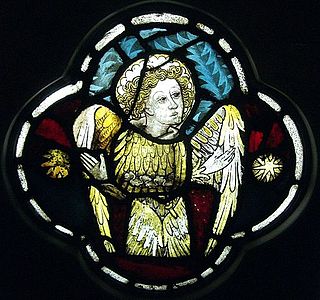 W
WFeather tights is the name usually given by art historians to a form of costume seen on Late Medieval depictions of angels, which shows them as if wearing a body suit with large scale-like overlapping downward-pointing elements representing feathers, as well as having large wings. Other sources use feathered angels to describe the style. The style is assumed to derive from actual costumes worn by those playing angels in medieval religious drama, with the "feathered" elements presumably flaps or lappets of cloth or leather sewn onto a body suit. The feathers on angels in art can often to be seen to stop abruptly at the neck, wrists and ankles, sometimes with a visible hemline, reflecting these originals.
 W
WLeadlights, leaded lights or leaded windows are decorative windows made of small sections of glass supported in lead cames. The technique of creating windows using glass and lead came is discussed at came glasswork. The term leadlight could be used to describe all windows in which the glass is supported by lead, but traditionally and correctly, a distinction is made between stained glass windows and leadlights, the former being associated with the ornate painted images on windows of churches and other such works of architecture and the latter with the windows of vernacular commercial and domestic architecture and defined by its simplicity.
 W
WLye Church is a medieval church on Gotland, Sweden. The oldest parts of the church date from the last quarter of the 12th century, and the last major addition was the disproportionately large chancel, built during the second quarter of the 14th century by a workshop known by its notname as Egypticus. The workshop was also responsible for constructing the largest of the church portals, which is also decorated with Gothic stone sculpture. The tower portal contains sculptures attributed to the Romanesque sculptor Sigraf. The church has been little altered since the end of the Middle Ages. Lye Church contains the largest preserved set of medieval stained glass windows in the Nordic countries, and its interior is also decorated by medieval wall paintings, uncovered in the 1950s. The altarpiece is from 1496, and the church also contains a triumphal cross from the same period.
 W
WMedieval stained glass is the coloured and painted glass of medieval Europe from the 10th century to the 16th century. For much of this period stained glass windows were the major pictorial art form, particularly in northern France, Germany and England, where windows tended to be larger than in southern Europe. In some countries, such as in Sweden and in England, only a fragment of an originally large amount of stained glass have survived to this day.
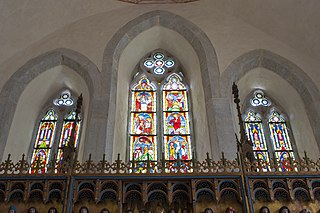 W
WThe surviving amount of medieval stained glass in Sweden is relatively small, compared to some other European countries. There are in total 165 medieval stained glass panes with figurative depictions surviving in 37 churches, constituting a total area of about 60 square metres (650 sq ft), a fragment of the original amount but still the largest amount found in any of the Nordic countries. Archaeological evidence and old drawings indicate that many more once existed.
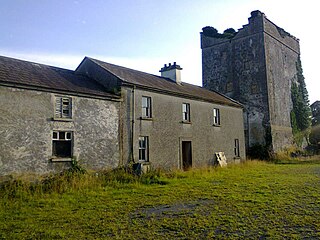 W
WMonivea Castle is a former O'Kelly tower house, located near Monivea in County Galway, Ireland. It was acquired by the ffrench family, one of the fourteen Tribes of Galway, who developed it further, enhancing the lands and building the Monivea Castle—all increasing the fortification around the original Norman tower.
 W
WMunich-style stained glass was produced in the Royal Bavarian Stained Glass Manufactory, Munich, in the mid-19th century.
 W
WNotre-Dame-des-Missions-du-cygne d'Enghien is a French Roman Catholic church located in the commune of Épinay-sur-Seine, near Paris and in the Seine-Saint-Denis department. Designed by Paul Tournon, decorated by many major artists of the day, and consecrated in 1932, the church is considered one of the most significant examples of modern ecclesiastical design in France.
 W
WIn French Gothic architecture, Rayonnant is the period from about the mid-13th century to mid-14th century It was characterized by a shift away from the High Gothic search for increasingly large size toward more spatial unity, refined decoration, and additional and larger windows, which filled the space with light. Prominent features of Rayonnant include the large rose window, more windows in the upper-level clerestory; the reduction of the importance of the transept; and larger openings on the ground floor to establish greater communication between the central vessel and the side aisles. Interior decoration increased, and the decorative motifs spread to the outside, to the facade and the buttresses. utilizing great scale and spatial rationalism towards a greater concern for two dimensional surfaces and the repetition of decorative motifs at different scales. The use of tracery gradually spread from the stained glass windows to areas of stonework, and to architectural features such as gables.
 W
WRoots of Knowledge is a permanent stained glass display completed in 2016 at Utah Valley University (UVU) in Orem, Utah, United States. The creation of the exhibit was designed and overseen by stained glass artists Tom Holdman and Cameron Oscarson. It took over 12 years and cost US$4.5 million to complete.
 W
WRose window is often used as a generic term applied to a circular window, but is especially used for those found in Gothic cathedrals and churches. The windows are divided into segments by stone mullions and tracery. The term rose window was not used before the 17th century and according to the Oxford English Dictionary, among other authorities, comes from the English flower name rose.
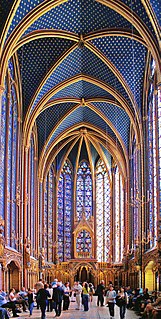 W
WThe Sainte-Chapelle is a royal chapel in the Gothic style, within the medieval Palais de la Cité, the residence of the Kings of France until the 14th century, on the Île de la Cité in the River Seine in Paris, France.
 W
WThe term stained glass refers to coloured glass as a material and to works created from it. Throughout its thousand-year history, the term has been applied almost exclusively to the windows of churches and other significant religious buildings. Although traditionally made in flat panels and used as windows, the creations of modern stained glass artists also include three-dimensional structures and sculpture. Modern vernacular usage has often extended the term "stained glass" to include domestic lead light and objets d'art created from foil glasswork exemplified in the famous lamps of Louis Comfort Tiffany.
 W
WThe Sint Janskerk in Gouda, the Netherlands, is a large Gothic church, known especially for its stained glass windows, for which it has been placed on the UNESCO list of Dutch monuments.
 W
WThe Stamford Cone is a 14-metre-high (46 ft) stained glass structural artwork, commissioned as a site-specific artwork for the headquarters building of UBS AG and landmark feature for the city of Stamford, Connecticut. The structure, in the shape of a cone, was designed and fabricated by British artist Brian Clarke, and is formed entirely of glass, combining 204 panels of laminated mouth-blown glass with 16 fins of laminated, toughened glass, with steel ring beams and tension cables the only non-glass elements. Completed in 1999 at a cost of over $1 million, the work was executed jointly by Clarke, architects Skidmore, Owings & Merrill, and engineered by Goldreich Engineering and Dewhurst MacFarlane & Partners. At the time of its completion, the artwork was the largest free-standing glass structure ever made.
 W
WA Standesscheibe is a stained glass that presents a coat of arms of a canton of the Old Swiss Confederacy. It is sometimes arranged in a complete armorial of all cantonal coats of arms of Switzerland. A standessheibe is an example of a wappenscheibe, a coat of arms depicted in a stained glass window.
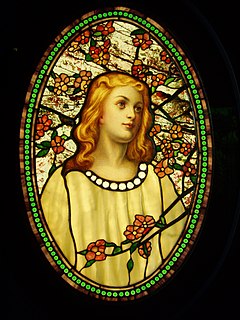 W
WTiffany glass refers to the many and varied types of glass developed and produced from 1878 to 1933 at the Tiffany Studios in New York, by Louis Comfort Tiffany and a team of other designers, including Frederick Wilson and Clara Driscoll.
 W
WThe Tree of Jesse is a depiction in art of the ancestors of Christ, shown in a tree which rises from Jesse of Bethlehem, the father of King David and is the original use of the family tree as a schematic representation of a genealogy. It originates in a passage in the biblical Book of Isaiah which describes metaphorically the descent of the Messiah, and is accepted by Christians as referring to Jesus. The various figures depicted in the lineage of Jesus are drawn from those names listed in the Gospel of Matthew and the Gospel of Luke.
 W
WAll Saints' Church in Tudeley, Kent, England, is the only church in the world that has all its windows in stained glass designed by Marc Chagall.
 W
WWaterford is a village in the East Hertfordshire district of Hertfordshire, England. It is located on the A119 road, around 2.5 km north of Hertford. The River Beane flows through the village. It is in the civil parish of Stapleford.
 W
W